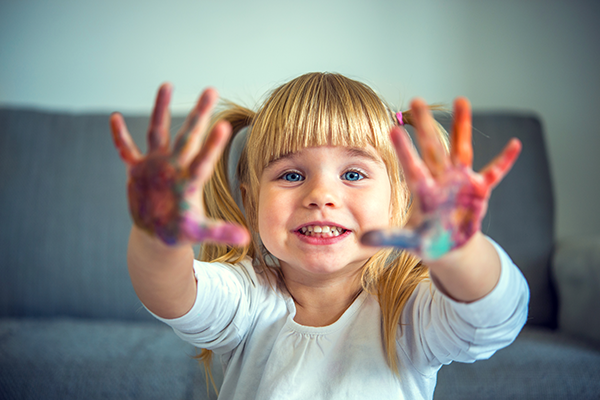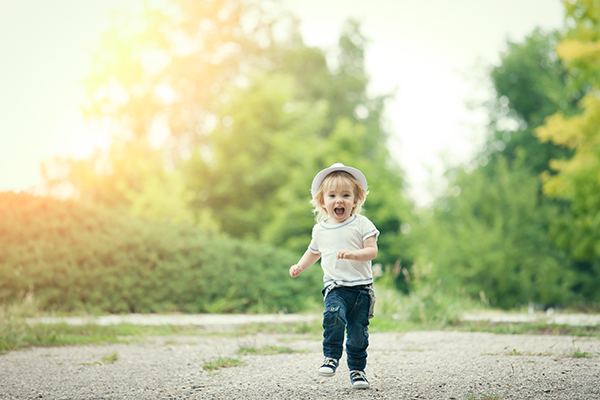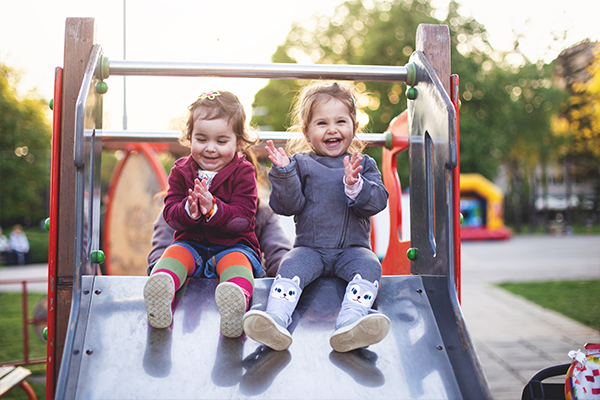Development Milestones for Your 3-Year-Old Child
Call today to schedule an appointment with one of our pediatricians.

3-Year-Old Developmental Milestones
To help understand your 3-year-old‘s development, doctors use certain milestones to tell if your child is developing as expected. There is a wide range of what is considered normal, so some children gain skills earlier or later than others. Toddlers who were born prematurely may reach milestones later. Always talk with your doctor about your child’s progress.
Children at this age love to play games of make-believe. However, their imaginations can sometimes run away with them and even spook them. Listen to your child’s fears and be there to comfort and reassure him or her when needed. There are many other 3-year-old developmental areas and milestones that will be reviewed in this article.
How much will my 3-year-old child grow?
In 3-year-olds, growth is still slow compared to the first year. Most children have become slimmer and lost the rounded tummy of a toddler. While all children may grow at a different rate, the following indicate the average for 3-year-old boys and girls:
- Weight: average gain of about 4 to 6 pounds per year
- Height: average growth of about 2 to 3 inches per year
After age 2, children of the same age can noticeably vary in height and weight. Although kids come in all shapes and sizes, a healthy toddler should continue to grow at a regular pace. The doctor will measure and weigh your child at routine checkups and plot the results on a growth chart. This lets the doctor track your child’s growth over time and spot any trends that need attention. As long as your child is maintaining his or her own rate of growth, there should be no reason to worry. A consultation with your child’s pediatrician is recommended if there is cause for concern.
Helping Kids Grow
Normal growth — supported by good nutrition, plenty of sleep and regular exercise — is one of the best overall indicators of a child’s good health.
Your toddler’s appetite may vary greatly now, which is common. It is also common for some toddlers to get stuck on one food. Food “jags” usually don’t last long if you don’t give in to them. Keep serving a variety of nutritious foods and let your child decide which and how much of them to eat, in order to build healthy eating habits.
Your child’s growth pattern is largely determined by genetics. Pushing children to eat extra food or more than the recommended amounts of vitamins, minerals or other nutrients will not increase their weight. Malnutrition, severe enough to affect growth rate, is uncommon today in the United States and other developed countries unless a child also has a related chronic illness or disorder.
What can my 3-year-old child do at this age?
As your child continues to grow, you will notice new and exciting abilities that develop. While children may progress at different rates, the following are some of the common milestones your child may reach in this age group:
- Runs and jumps easily
- Walks upstairs unassisted
- Rides a tricycle
- Washes and dries hands
- Stacks 10 blocks
- Easily draws straight lines and copies a circle
- Can stand on tip-toes
- Uses spoon well and feeds self
- Dresses and undresses self except for buttons and laces
- Can concentrate on tasks for eight or nine minutes
- Has all 20 primary (“baby”) teeth
- Vision is nearing 20/20
- Bladder and bowel control are usually established; uses potty chair or toilet
- May sleep 11 to 13 hours total, may still take a short afternoon nap

What can my 3-year-old child say?
Speech development is very exciting as you watch your child begin to speak clearly and interact with others. While every child develops speech at his or her own rate, the following are some of the common milestones in this age group:
- Should be able to say about 500 to 900 words between ages 3 to 4 years old
- Speech can be understood by others
- Speaks in two or three word sentences and progresses to four- to five-word sentences
- Can remember simple rhymes or lyrics
- Uses “please” and “thank you”
- Refers to self by using own name
- Names colors
What does my 3-year-old child understand?
While children may progress at different rates, the following are some of the common milestones your child may reach in this age group:
- Understands size differences (such as, big and little)
- Understands past tense (yesterday)
- Understands long sentences
- Understands prepositions (on, under, behind)
- Uses pronouns correctly (such as, I, you, he and me)
- Asks “why” constantly
- Counts up to four objects by 4 years old
- Says full name and age
- May have fears of certain things (for example, dark, monster under bed and going down the drain)
- Attempts to solve problems
- Remembers certain events
- Can point to the correct picture when asked a simple question about it
How does my 3-year-old child interact with others?
While every child is unique and will develop different personalities, the following are some of the common behavioral traits that may be present in your child:
- Begins to share and likes to play with other children
- Can take turns
- Temper tantrums are less frequent
- Begins to show feelings in socially acceptable ways
Physical Activities for 3-Year-Olds
At this age, your child is extremely active, mobile and learning in very physical ways. Children at this age are walking, running, kicking and throwing. They are exploring their world and picking up new skills, like kicking a ball or riding a tricycle.
3-year-olds are naturally active, so be sure to provide ample chances for your child to practice and build on these skills. How much is enough? Physical activity guidelines for toddlers recommend that each day they:
- Get at least 30 minutes of structured (adult-led) physical activity.
- Get at least 60 minutes of unstructured (active free play) physical activity.
- Not be inactive for more than 1 hour at a time except when sleeping.

Family Fitness Tips
Walking, playing, exploring your backyard or using playground equipment at a local park can be fun for the entire family. Also, these games provide fun and fitness for parents and toddlers:
- Walk like a penguin, hop like a frog or imitate other animals’ movements.
- Sit facing each other and hold hands. Rock back and forth and sing the song “Row, row, row your boat.”
- Bend at the waist and touch the ground. Walk your hands forward and inch along like a caterpillar.
- Sit on the ground and let your child step over your legs, or make a bridge with your body and let your child crawl under.
- Play follow the leader, “Ring around the rosy,” and other similar games.
- Listen to music and dance together.
The possibilities are endless — come up with your own active ideas or follow your child’s lead. Focusing on these activities can also help limit the amount of time your child spends watching TV or playing on a computer, tablet or smartphone.
How long should my 3-year-old sleep?
A 3-year-old needs about 11-13 hours of sleep total. They may still take a short nap throughout the day, but a child can outgrow naptimes at this age. They do not need exact sleep times, but it is important to help children develop good, consistent habits for going to sleep. A bedtime routine is a great way to help your 3-year-old get enough sleep. Here are some tips when creating a routine:
- Avoid caffeine or sugar before bed
- Limit food and drink before bedtime
- Include a winding-down period during the half hour before bedtime
Check out our Healthy Sleep for Children for more info.
How can I help increase my 3-year-old child’s learning and emotional security?
Consider the following as ways to foster the emotional security of your 3-year-old:
- Spend time allowing your child to talk with you
- Teach your child how things work
- Encourage play with other children
- Encourage your child to tell you stories
- Listen to your child and show that you are pleased by your child’s talking
- Let your child do as much as possible for himself or herself when getting dressed, brushing teeth, and combing hair
- Have your child help with simple chores such as picking up toys
- Give your child old clothes for “dress up” and allow him or her to pretend being a mom, dad, doctor, cowboy and the like (old sheets or towels can become skirts, capes or turbans. You can also pretend you are an elephant, butterfly, robot or other characters and play with your child)
- Sing songs or nursery rhymes and teach your child the words
- Read stories with your child and ask your child to name pictures in the stories or retell part of the story
- Help your child play with crayon and paper or chalk and chalkboard by showing how to draw circles and lines and then put them together to make a stick figure (make figure faces that are happy, sad or surprised, and talk about the different feeling shown in each picture)
- Let your child build things out of blocks or boxes
- Give your child a safe space to ride a tricycle
- Listen to children’s music with your child and dance
- Practice counting with your child
- Give your child the chance to play games with other children (church groups, YWCA or YMCA recreation centers, or libraries often have preschool programs)
- Put puzzles together with your child
- Let your child have pretend playtime with dolls, cars or toy cooking utensils
- Play hide and seek and follow the leader
- Let your child use his or her imagination by playing with play dough or clay
- Trace your child’s hand or whole body and make a picture
- Show your child you are proud of any artwork and hang it up for display
- Teach your child colors
- Play ball with your child (such as tossing a ball into a box or rolling the ball up and down an incline)
Reviewed by Dr. Toya Tillis, Pomona Pediatrics | CHOC Primary Care
June 2021